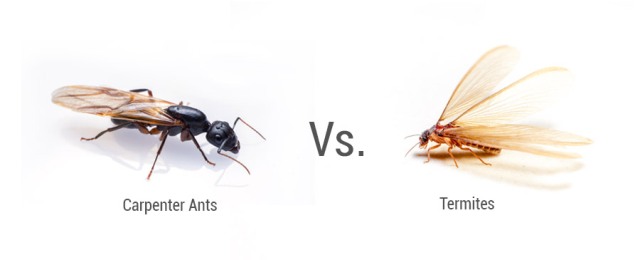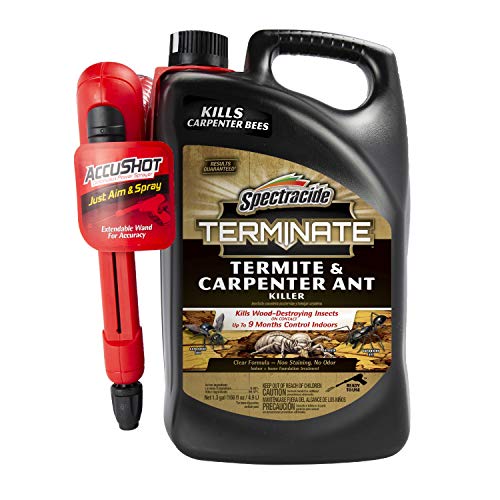Carpenter ants and termites can often be confused for one another. Their physical appearances are very similar, and the materials they infest have a lot in common as well. They both feed off of wood and other cellulose materials, so homeowners can be easily tricked into thinking they have an infestation of one instead of another. By taking close notice of certain differences between the two insects, it is easy to distinguish them from one another. Termite are probably the most underestimated insect out there. They are a gigantic problem in this country with homeowners needing to protect their homes from termites on a yearly basis. But because they are not as well known as other pests, many people tend to mix them up with other insects such as carpenter ants. So then what is the difference between carpenter ants and termites? Do you need both treated if you have an infestation? Is one worse than the other for your home? Carpenter ants and termites are two insects commonly mistaken for each other. As a matter of fact, many people do not know the differences between these two insects. People often use the names interchangeably to describe both insects but there are more differences than similarities between them. While carpenter ants and termites both look alike and produce damage to wood, they are different insects.
Difference Between Carpenter Ants And Termites
Introduction
Carpenter ants and termites are two wood-destroying insects that can cause severe damage to homes. Both of these insects build tunnels through wood, and both of them can be found all over the United States. While they have a lot in common, however, they vary greatly in certain respects. A good understanding of the differences between carpenter ants and termites will help you to identify these pests when you encounter them. You’ll also be able to detect structural problems early on before they cause too much damage or become infestations.
What is the Difference Between Carpenter Ants And Termites?
And what is the difference between carpenter ants and termites?
Both of these insects are wood-destroying pests that can cause damage to your home. They’re social insects, so they live in colonies with many queens and workers. While carpenter ants nest in wood, their diet consists mostly of sugar-rich foods like maple syrup or honeydew from aphids—they don’t feed on your home’s structural material. Termites, on the other hand, eat cellulose (wood) and have complex systems for digesting it (such as using fungi). They also produce waste while they eat that they need to remove from their colony on a regular basis—this waste is called frass because it looks like sawdust when it comes out of their bodies through special openings called “frass tubes.”
Carpenter Ants
Carpenter ants are black and red with a body that is usually 1/2 to 3/4 of an inch long. They are most commonly found in the eastern and southern United States. Carpenter ants can be identified by their large heads, which have strong jaws that they use to chew wood and make tunnels underground.
Termites
Termites are wood-eating insects. They have a social structure similar to ants, but termites are not as aggressive or destructive as ants. Although termites are not easy to identify by sight, their presence is often indicated by drywood, powderpost, or dampwood termite damage.
Termites are smaller than carpenter ants and tend to be light in color; they lack the dark abdomen of carpenter ants. The most common species found in California is the subterranean termite Reticulitermes santonensis. The eastern subterranean (Reticulitermes flavipes) was introduced into California sometime before 1932 and can be found in several counties including Los Angeles and San Francisco Counties.
Summary of the Difference Between Carpenter Ants And Termites
The major difference between carpenter ants and termites is that while both insects can cause damage to the wood in your home, termites eat wood and carpenter ants also eat non-wood materials. Unfortunately, this makes them more difficult to control because they will continue to eat away at whatever they find until you find and eliminate them. Termites are also more destructive than carpenter ants because they use their long heads (called “snouts”) as tools for boring into wood with powerful jaws so that they can feed on it later. Carpenter ants do not have such a specialized tool for getting into your home’s structure; instead, they simply bore small holes into it with their mandibles (the two main parts of an insect’s mouth).
Carpenter ants are also more expensive than termites because of how much damage they can cause if left untreated for too long; however, treatment costs vary depending on the extent of infestation and whether additional repairs are necessary after eliminating them from your house or building.
* Carpenter ants and termites both tunnel through wood.
Although carpenter ants and termites both tunnel through wood, they are two different insects. The main difference is that carpenter ants have a caste system, which is not present in termites. This means that the queen will lay eggs and some of them will become workers or soldiers and others will turn into males. In contrast to this situation, there are no castes for termites because their eggs hatch into nymphs that all look alike. They develop into adults by molting their skin several times as they grow older until they reach adulthood after about two years (Bender & Bruch 1959).
Additionally, carpenter ants consume mostly plant materials whereas most species of termite feed on cellulose material such as wood but some species may also consume non-cellulose materials like grasses or dead leaves (Wille 1991). Furthermore, termites live in colonies while carpenter ants live alone (except when mating) so you can find many colonies near each other instead of just one big colony like you would see with termites (Soto-Adames 2010).
* Both of these insects are considered structural pests, because they damage wood in homes.
Both carpenter ants and termites are considered structural pests because they damage wood in homes. Both insects tunnel through wood, making it a good food source for them.
Termites have soft bodies that resemble white or greyish-white worms with pin-like mouthparts. They eat cellulose, the main component of plant cell walls, which makes up about 25% of house framing materials like plywood, wallboard and lumber. Carpenter ants are large black or brown insects with long legs and antennae; they often nest outdoors but will move indoors during hot weather to find moisture or cooler temperatures.
Conclusion
As a homeowner, it is important to understand the difference between carpenter ants and termites. In this article, we have provided a comparison of these two insects. We have also given a summary of the difference between carpenter ants and termites.
- Meet the Echo Dot – Our most popular smart speaker with Alexa. The sleek, compact design delivers crisp vocals and balanced bass for full sound.
- Voice control your entertainment – Stream songs from Amazon Music, Apple Music, Spotify, SiriusXM, and others. Play music, audiobooks, and podcasts throughout your home with multi-room music.
- Ready to help – Ask Alexa to tell a joke, play music, answer questions, play the news, check the weather, set alarms, and more.
- Control your smart home – Use your voice to turn on lights, adjust thermostats, and lock doors with compatible devices.
- Start Routines with your motion – Turn on compatible lights, play your Flash Briefing, or turn on the coffee maker when you walk into the room.
- Connect with others hands-free – Call friends and family who have the Alexa app or an Echo device. Instantly drop in on other rooms or announce to the whole house that dinner’s ready.
- Designed to protect your privacy – Amazon is not in the business of selling your personal information to others. Built with multiple layers of privacy controls including a mic off button.
Additional Info :
| Color | Charcoal |
| Item Dimensions | |
| Height | 3.53 Inches |
| Width | 3.94 Inches |
| Length | 3.94 Inches |
| Weight | 0.752437700206 Pounds |
| Release Date | 2020-10-22T00:00:01Z |
- KILLS TERMITES AND CARPENTER ANTS: Indoor plus home foundation treatment against termites, carpenter ants, carpenter bees and other insects as listed.
- FOR INDOOR AND OUTDOOR USE: Up to 9 months control indoors
- KILLS CARPENTER BEES: Kills wood-destroying insects on contact.
- CLEAR FORMULA: Non-staining spray leaves no odor.
- ACCUSHOT SPRAYER: Continuous power sprayer for precise application.
Additional Info :
| Item Dimensions | |
| Height | 12.53 Inches |
| Width | 9.5 Inches |
| Length | 5.5 Inches |
| Weight | 12.25 Pounds |
- Safe
- Extra Concentrated for Long-Lasting Protection
- Natural Ingredients Proven Effective in the Real World
- Large 16oz Bottle
- Powerful Essential Oil
Additional Info :
| Item Dimensions | |
| Weight | 1 Pounds |
- Attracts & Kills – Kills common household ants including acrobat, crazy, ghost, little black, odorous house, pavement, and other sweet-eating ants
- Kills the Ants You See & the Ones You Don’t – As worker ants discover the bait, they share it with the rest of the colony to eliminate them all
- Works Fast – You should see a significant decrease in the number of ants visiting the bait stations within just a few days
- Ready to Use – Place the bait stations, watch it attract ants, and eliminate the entire colony
- Use Throughout Your Home – Place stations near areas where you’ve seen ant activity including along baseboards, in corners, on counters, and more
Additional Info :
| Item Dimensions | |
| Height | 4.5 Inches |
| Width | 6.6 Inches |
| Length | 1.2 Inches |
| Weight | 0.27 Pounds |
- You MUST ALWAS RED THE LABEL BEFORE USIN THE PRDUCT! !
- cmpany and distbutr of pest control produc. PesControl Pros can not or guaant the safety of the products listed on our website as this solely lies with the manufacturer of the product. Products sold on this site are sold throughout the world and it is impossible to know every licensing restriction or requirements, product registration, etc. for every country, state, county, city, province, etc.
- ou MUST ALWAYS READ THE LABEL BEFORE USING THE PRODUCT! !
- Package Weight: 0.068 kilograms
Additional Info :
| Color | white |
| Item Dimensions | |
| Height | 7 Inches |
| Width | 4 Inches |
| Length | 3.8 Inches |
| Weight | 0.67 Pounds |





